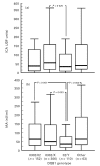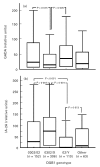Disease-associated autoantibodies and HLA-DQB1 genotypes in children with newly diagnosed insulin-dependent diabetes mellitus (IDDM). The Childhood Diabetes in Finland Study Group
- PMID: 10209508
- PMCID: PMC1905229
- DOI: 10.1046/j.1365-2249.1999.00863.x
Disease-associated autoantibodies and HLA-DQB1 genotypes in children with newly diagnosed insulin-dependent diabetes mellitus (IDDM). The Childhood Diabetes in Finland Study Group
Abstract
The possible relation between HLA-DQ genotypes and both frequencies and levels of autoantibodies associated with IDDM was assessed by examining HLA-DQB1 alleles and antibodies to islet cells (ICA), insulin (IAA), glutamic acid decarboxylase (GADA) and the protein tyrosine phosphatase-related IA-2 molecule (IA-2A) in 631 newly diagnosed diabetic children under the age of 15 years. ICA were found in 530 children (84.0%), while close to half of the subjects (n = 307; 48.7%) tested positive for IAA. GADA were detected in 461 index cases (73.1%), with a higher frequency in those older than 10 years (78.9% versus 69.2% in the younger ones; P = 0.006). More than 85% of the children (n = 541; 85.7%) tested positive for IA-2A. Altogether there were only 11 children (1.7%) who had no detectable autoantibodies at diagnosis. There were no differences in the prevalence of ICA or GADA between four groups formed according to their HLA-DQB1 genotype (DQB1*0302/02, *0302/X (X = other than *02), *02/Y (Y = other than *0302) and other DQB1 genotypes). The children with the *0302/X genotype had a higher frequency of IA-2A and IAA than those carrying the *02/Y genotype (93.8% versus 67.3%, P < 0.001; and 49.0% versus 33.6%, P = 0.002, respectively). The children with the *02/Y genotype had the highest GADA levels (median 36.2 relative units (RU) versus 14.9 RU in those with *0302/X; P = 0.005). Serum levels of IA-2A and IAA were increased among subjects carrying the *0302/X genotype (median 76.1 RU versus 1.6 RU, P = 0.001; and 50 nU/ml versus 36 nU/ml, P = 0.004) compared with those positive for *02/Y. Only three out of 11 subjects homozygous for *02 (27.3%) tested positive for IA-2A, and they had particularly low IA-2A (median 0.23 RU versus 47.6 RU in the other subjects; P < 0.001). The distribution of HLA-DQB1 genotypes among autoantibody-negative children was similar to that in the other patients. These results show that DQB1*0302, the most important single IDDM susceptibility allele, is associated with a strong antibody response to IA-2 and insulin, while GAD-specific humoral autoimmunity is linked to the *02 allele, in common with a series of other autoimmune diseases as well as IDDM. We suggest that IA-2A may represent beta cell-specific autoimmunity, while GADA may represent a propensity to general autoimmunity.
Figures


Similar articles
-
Humoral beta-cell autoimmunity in relation to HLA-defined disease susceptibility in preclinical and clinical type 1 diabetes.Am J Med Genet. 2002 May 30;115(1):48-54. doi: 10.1002/ajmg.10343. Am J Med Genet. 2002. PMID: 12116176 Review.
-
Islet autoantibodies are associated with HLA-DQ genotypes in Han Chinese patients with type 1 diabetes and their relatives.Tissue Antigens. 2007 Nov;70(5):369-75. doi: 10.1111/j.1399-0039.2007.00916.x. Tissue Antigens. 2007. PMID: 17919266
-
Human leukocyte antigen identity and DQ risk alleles in autoantibody-positive siblings of children with IDDM are associated with reduced early insulin response. Childhood Diabetes in Finland (DiMe) Study Group.Diabetes. 1995 Sep;44(9):1021-8. doi: 10.2337/diab.44.9.1021. Diabetes. 1995. PMID: 7657023
-
[Relationship between autoantibodies and HLA-DQ genotypes in patients with type 1 diabetes mellitus].Zhonghua Yi Xue Za Zhi. 2007 Sep 11;87(34):2380-4. Zhonghua Yi Xue Za Zhi. 2007. PMID: 18036312 Chinese.
-
International Workshop on Lessons From Animal Models for Human Type 1 Diabetes: identification of insulin but not glutamic acid decarboxylase or IA-2 as specific autoantigens of humoral autoimmunity in nonobese diabetic mice.Diabetes. 2001 Nov;50(11):2451-8. doi: 10.2337/diabetes.50.11.2451. Diabetes. 2001. PMID: 11679421 Review.
Cited by
-
Beta-cell, thyroid, gastric, adrenal and coeliac autoimmunity and HLA-DQ types in type 1 diabetes.Clin Exp Immunol. 2001 Nov;126(2):236-41. doi: 10.1046/j.1365-2249.2001.01668.x. Clin Exp Immunol. 2001. PMID: 11703366 Free PMC article.
-
Lymphoid tyrosine phosphatase (LYP/PTPN22) Arg620Trp variant regulates insulin autoimmunity and progression to type 1 diabetes.Diabetologia. 2006 Jun;49(6):1198-208. doi: 10.1007/s00125-006-0225-4. Epub 2006 Apr 14. Diabetologia. 2006. PMID: 16614815
-
Human Leukocyte Antigen-Disease Associations in Rheumatoid Arthritis.Rheum Dis Clin North Am. 2017 Aug;43(3):363-376. doi: 10.1016/j.rdc.2017.04.003. Rheum Dis Clin North Am. 2017. PMID: 28711139 Free PMC article. Review.
-
First-emerging islet autoantibody and glucose metabolism: search for type 1 diabetes subtypes.Endocr Connect. 2022 Aug 17;11(9):e210632. doi: 10.1530/EC-21-0632. Print 2022 Sep 1. Endocr Connect. 2022. PMID: 35900772 Free PMC article.
-
The Multifactorial Progression from the Islet Autoimmunity to Type 1 Diabetes in Children.Int J Mol Sci. 2021 Jul 13;22(14):7493. doi: 10.3390/ijms22147493. Int J Mol Sci. 2021. PMID: 34299114 Free PMC article. Review.
References
-
- Atkinson MA, Maclaren NK. What causes diabetes? Sci Am. 1990;263:62–71. - PubMed
-
- Tarn AC, Thomas JM, Dean BM, Ingram D, Schwartz G, Bottazzo GF, Gale EA. Predicting insulin-dependent diabetes. Lancet. 1988;2:845–50. - PubMed
-
- Christie MR, Tun RY, Lo SS, et al. Antibodies to GAD and tryptic fragments of islet 64K antigen as distinct markers for development of IDDM. Studies with identical twins. Diabetes. 1992;41:782–7. - PubMed
-
- Karjalainen J, Vähäsalo P, Knip M, Tuomilehto-Wolf E, Virtala E, Åkerblom HK. the Childhood Diabetes in Finland Study Group. Islet cell autoimmunity and progression to insulin-dependent diabetes mellitus in high- and low-risk siblings of diabetic children. Eur J Clin Invest. 1996;26:640–9. - PubMed
-
- Verge CF, Gianini R, Kawasaki E, Yu L, Pietropaolo M, Jackson RA, Chase HP, Eisenbarth GS. Prediction of type 1 diabetes in first-degree relatives using a combination of insulin, GAD and ICA512bdc/IA-2 antibodies. Diabetes. 1996;45:926–33. - PubMed
Publication types
MeSH terms
Substances
Grants and funding
LinkOut - more resources
Full Text Sources
Medical
Research Materials
Miscellaneous

